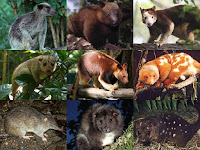On top of that, each line of the song was a reference to an actual Maui legend. In case anyone wants to do more readings, I threw together this handy list of the stories references in the song.
First up, a clip from the movie:
And here is the full song (audio only):
And now, for the references:
"What has two thumbs that hold up the sky
When you were waddling yay high
This guy!"
Maui lifting the sky
It is a common motif in Polynesian mythologies that in the beginning Earth and Sky were too close together. Someone, or someones had to lift the sky so that things could grow, and people could stand up. In many stories it was Maui who did the deed, thanks to his superhuman strength (in some version, he did it together with his father).
"When the nights got cold
Who stole you fire from down below
You're lookin' at him, yo"
Maui brings fire to the world
In what is probably my favorite Maui legend, Maui wanted to know where fire comes from - so he put out all fires in his village, and waited for the elders to send him on a quest. He went to visit Mahuika, the goddess of fire who lived inside the mountain, and asked for fire. She gave him one of her nails, but Maui suddenly got curious about where her own fire comes from, so he kept putting out the nails and going back for more, until she ran out. Mahuika attacked him in anger, missed, and her fire landed on some trees - ever since then, wood can be used to make fire.
"Oh, also I lassoed the sun
You're welcome!
To stretch the days and bring you fun"
 |
| Picture from here |
There are several legends that say that the Sun used to cross the sky too fast, and people did not have time to do their daily tasks. Eventually Maui (and, in some cases, his brothers) lassoed the Sun, and threatened it into slowing down, giving the world longer days. Fun fact: in some stories, Maui did this to help his mom, Hina, with drying her clothes.
(Here is another version)
"Also I harnessed the breeze
You're welcome!
To fill your sails and shake your trees"
Maui's kite flying
In this fun legend Maui has a giant kite (made for him by his mother), and he tries to fly it, but doesn't have enough breeze. He asks an old priest, who holds the winds in a gourd, to let more and more of them out, until the kite flies high up, breaks its rope, and escapes. If you watch the clip from the movie, you can see Maui flying his kite in the corresponding tattoo. Nice touch.
"So what can I say except you're welcome
For the islands I pulled from the sea"
Maui fishes for islands
There are several stories both in Hawaii and New Zealand about Maui fishing islands up from the bottom of the ocean (sometimes in the form of a giant fish). These origin legends explain the birth of the Hawaiian island chain, as well as the north island of New Zealand.
"I killed an eel, I buried its guts
Sprouted a tree, now we've got coconuts."
The origin of the coconut
First off, for some reason some lyrics I found said "snake", but in all stories it's a giant eel. His name is Te Tuna (sometimes just called Tuna), and he is a sea spirit that either sleeps with, or wants to sleep with, Maui's wife (or a woman he loves). Maui fights and kills the eel, cuts its head off, and buries it - the first coconut palm sprouts from the head (hence the "face" on the coconuts).
(Here is another version)
Of course these are just texts that I could rustle up online. Here are some resources for further reading:
The University of Hawaii's Hawaiian Legends Index
Maori Myths, Legends, and Contemporary Stories (from Te Kete Ipurangi, New Zealand's bilingual education portal)
Maori Myth and Legend Resources (from the National Library of New Zealand)
Hawaiian Legends of Tricksters and Riddlers (from University of Hawai'i Press, with an extensive bibliography)
Dictionary of Polynesian Mythology
Whatever the strengths and weaknesses of the movie are, it can hopefully point people in the direction of reading more on their own. I am just getting started myself...
















